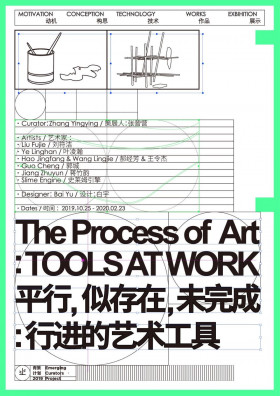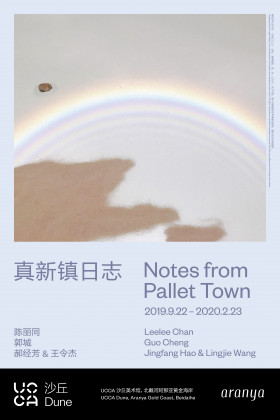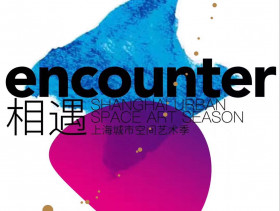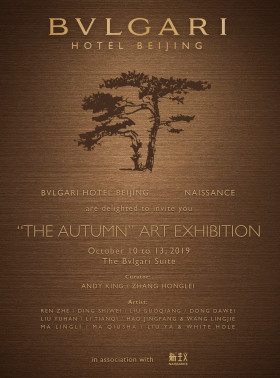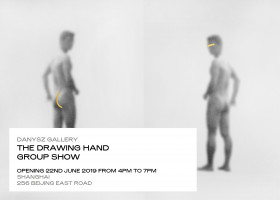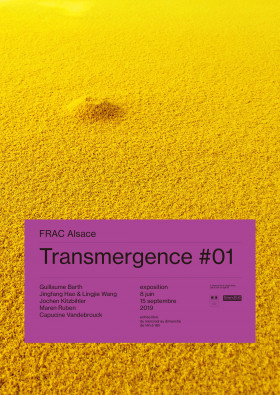The Process of Art: TOOLS AT WORK
Curator: Zhang Yingying
Artists: Guo Cheng, Hao Jingfang & Wang Lingjie, Jiang Zhuyun, Liu Fujie, Slime Engine, and Ye Linghan
About the Exhibition: As a definable movement, Conceptual Art in the 1960s-1970s attempted to bypass the increasingly commercialized art world, emphasizing that “thinking process and production methods are the value of artworks”. As a mysterious bridge, tools have realized the visual transformation of artworks from virtual individual consciousness to tangible objects. An artist’s conception itself does not constitute art – but if the artist seeks to materialize it, he or she must utilize the power of technology and tool. Tool is a clue that can return to the essence of art. As a part of artists’ practical behavior, it has its own way of seeing. This approach guides artists to operate, and makes the operations own their specific material properties.
Manufacturing, manipulating, editing or processing represent a way of art’s uncovering as well as a pattern of creating an open area and revealing truth within – they are closely related to the emergence of art essence. When works lose themselves in the art market or fall into theoretical crisis, tools become a gradual link – a link that can produce infinity, a link that has creativity to break the existing cognition, and a link that carries out the internal test of art. It makes us re-examine the creation of art again…
About the Curator: Zhang Yingying is a Shanghai-based curator and writer. She started to engage artistic creations in 2010, turned to art review and focused research on Kassel Documenta in 2015, and devoted to curatorial practices in 2017, searching for the best fitting points between art, theory and social reality from basic elements.
Emerging Curators Project 2019
Time: October 25, 2019 – February 23, 2020
Venue: Gallery 1, 1F, PSA
Organizer: Power Station of Art
Special Thanks to: Consulate General of France in Shanghai, Pro Helvetia Shanghai
Special Partner: TOTO (China) Co., Ltd.
Support: Shanghai HELU Culture Communication Co.Ltd., Project Woo
Admission: Free
About Emerging Curators Project
PSA’s Emerging Curators Project is China’s exclusive young curator development and research project. As the contemporary art museum’s annual exhibitory and academic trademark, the project stays committed to exploring young Chinese curatorial talents and providing them with a platform to practice conceptions, an opportunity to access comprehensive and in-depth guidance, a path to enter the public’s eyes, and an environment to enjoy healthy growth. Since its inception in 2014, the Emerging Curators Project has so far supported more than 30 Chinese curatorial talents to realize a total of 14 exhibitions. With an open and fair reviewing principle that disregards backgrounds and encourages adventures, the six-year-old project has been gradually rising to become an important platform for young Chinese curators. Through exhibition-based practices, young curators emerging on this platform gain experiences as well as attention from the industry, while some of the curatorial plans taking form here are also translating into sustainable research and exhibition projects.
About PSA
Established on October 1, 2012, the Power Station of Art (PSA) is the first state-run museum dedicated to contemporary art in mainland China. It is also home to the Shanghai Biennale. Renovated from the former Nanshi Power Plant, PSA was once the Pavilion of Future during the 2010 Shanghai World Expo. The museum has not only witnessed the city’s vast changes from the industry age to the IT era, but also provided a rich source of inspirations for artists with its simple yet straightforward architectural styles. And as Shanghai’s generator for its new urban culture, PSA regards non-stopping innovation and progress as the key to its long-term vitality. The museum has been striving to provide an open platform for the public to learn and appreciate contemporary art, break the barrier between life and art, and promote cooperation and knowledge generation between different schools of art and culture.
About Consulate General of France in Shanghai
The Consulate General of France in Shanghai represents the Service of Cooperation and Cultural Action of the Embassy of France in China, which bears a mission to spread the French culture, promote French education, and boost Sino-French cultural exchanges in China.
About Pro Helvetia Shanghai
Established by the Swiss Government in 1939, Pro Helvetia is dedicated to the promotion of contemporary cultural works of national and international interest. Pro Helvetia Shanghai, founded in 2010, carries an aim to encourage dialogue between Swiss and Chinese cultural practitioners and institutions by supporting projects that enhance the exchange of knowledge and experience in the cultural field. Most projects undertaken by Pro Helvetia Shanghai focus on Swiss contemporary art, with special emphasis placed on the disciplines of visual and performing arts, design and music.
 Fr
Fr 中文
中文